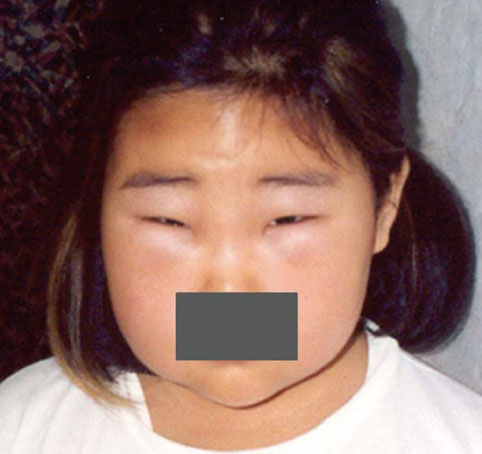Allergy Asthma Immunol Res.
2013 Jan;5(1):59-61. 10.4168/aair.2013.5.1.59.
A Case of Hereditary Angioedema in a 7-Year-Old Korean Girl
- Affiliations
-
- 1Department of Pediatrics, Soonchunhyang University Bucheon Hospital, Bucheon, Korea.
- 2Department of Pediatrics, Samsung Medical Center, Sungkyunkwan University School of Medicine, Seoul, Korea. kmaped@skku.edu
- KMID: 2167008
- DOI: http://doi.org/10.4168/aair.2013.5.1.59
Abstract
- Hereditary angioedema (HAE) is a rare autosomal dominant disease that usually occurs in adolescence and early adulthood. It is characterized by recurrent non-pitting edema involving the skin and intestinal tract, especially the extremities and face. It is not associated with urticaria and pruritus. The cause is known to be the deficiency of C1 inhibitor. We herein report a 7-year-old girl with HAE who had recurrent episodes of swelling of the extremities and face without urticaria and pruritus. Her great grandmother had suffered from the same symptoms. The level of serum C4 was 8.01 mg/dL (normal: 10-40 mg/dL). The level of C1 inhibitor was 5.0 mg/dL (normal: 18-40 mg/dL). To our knowledge, this is the first pediatric case with typical clinical symptoms of HAE and C1 esterase inhibitor deficiency in Korea.
Keyword
MeSH Terms
Figure
Cited by 1 articles
-
Clinical experience in managing patients with hereditary angioedema in Korea: questionnaire survey and a literature review
Suh-Young Lee, Hye-Ryun Kang, Jae Woo Jung, Gwang Cheon Jang, Soo Young Lee, Youngmin Ahn, Kyung-Up Min,
Allergy Asthma Respir Dis. 2014;2(4):277-284. doi: 10.4168/aard.2014.2.4.277.
Reference
-
1. Frank MM, Gelfand JA, Atkinson JP. Hereditary angioedema: the clinical syndrome and its management. Ann Intern Med. 1976. 84:580–593.2. Carreer FM. The C1 inhibitor deficiency. A review. Eur J Clin Chem Clin Biochem. 1992. 30:793–807.3. Cicardi M, Zanichelli A. Angioedema due to C1 inhibitor deficiency in 2010. Intern Emerg Med. 2010. 5:481–486.4. Bas M, Adams V, Suvorava T, Niehues T, Hoffmann TK, Kojda G. Nonallergic angioedema: role of bradykinin. Allergy. 2007. 62:842–856.5. Lee JH, Cho JY, Nam DH, Hong CS. A case of hereditary angioedema. Allergy. 1994. 14:695–701.6. Lee YS, Chung JH, Cho KH, Youn JI. A case of hereditary angioedema. Korean J Dermatol. 1994. 32:115–118.7. Suh KS, Kang JM, Kim KJ, Kang HJ. Three cases of hereditary angioedema in one family. Korean J Dermatol. 1995. 33:564–569.8. Lee JA, Nah BG, Jun H, Seo JC, Kim MK. A case of hereditary angioedema not manifestated classical autosomal dominant trait. Korean J Allergy. 1997. 17:574–579.9. Kim SH, Lee BJ, Chang YS, Kim YK, Cho SH, Min KU, Kim YY. A case of hereditary angioedema associated with idiopathic hypoparathyroidism. Korean J Intern Med. 2001. 16:281–283.10. Nzeako UC, Frigas E, Tremaine WJ. Hereditary angioedema: a broad review for clinicians. Arch Intern Med. 2001. 161:2417–2429.11. Weis M. Clinical review of hereditary angioedema: diagnosis and management. Postgrad Med. 2009. 121:113–120.12. Bork K, Witzke G. Long-term prophylaxis with C1-inhibitor (C1 INH) concentrate in patients with recurrent angioedema caused by hereditary and acquired C1-inhibitor deficiency. J Allergy Clin Immunol. 1989. 83:677–682.13. Frank MM. Hereditary angioedema. Curr Opin Pediatr. 2005. 17:686–689.14. Farkas H. Pediatric hereditary angioedema due to C1-inhibitor deficiency. Allergy Asthma Clin Immunol. 2010. 6:18.15. Bork K, Meng G, Staubach P, Hardt J. Hereditary angioedema: new findings concerning symptoms, affected organs, and course. Am J Med. 2006. 119:267–274.16. Kang HR, Yim EY, Oh SY, Chang YS, Kim YK, Cho SH, Min KU, Kim YY. Normal C1 inhibitor mRNA expression level in type I hereditary angioedema patients: newly found C1 inhibitor gene mutations. Allergy. 2006. 61:260–264.17. Suh JY, Choi JK, Lee HB, Park CK. Two cases of angioedema due to C1 inactivator deficiency. Pediatr Allergy Respir Dis. 1993. 3:121–127.18. Yoo MJ, Park IC, Lee HB, Kim YT. A clinical study of C1 inactivator deficiency in children with chronic urticaria-angioedema. Pediatr Allergy Respir Dis. 1994. 4:118–127.


